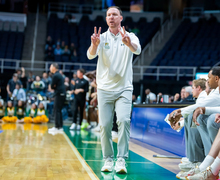With less than $300 million left to fundraise, The Campaign for Syracuse University is on track to reach its billion-dollar goal by 2012, said Thomas Walsh, the executive vice president for advancement and external affairs.
The billion-dollar campaign, which went public in 2007, is a capital fundraiser in which all monetary gifts to any part of the university are counted. Despite the recession, which brought heavy losses to SU’s endowment, donations to the university have remained steady, reaching more than $718 million by the beginning of April. But the campaign is entering a more difficult phase in its ability to raise money, Walsh said, which is necessary to build and complete many campaign initiatives.
“If we can maintain that $100 million a year in the next three years, we can finish the campaign on time,” Walsh said.
The university began counting money toward the billion-dollar campaign in July 2005 but didn’t announce the campaign until July 2007. The two quiet years, from 2005 to 2007, saw an unanticipated number of gifts to the university, totaling more than $500 million by the time the campaign went public, said Brian Sischo, SU’s vice president for development.
“The basic psychology is to have at least 40 percent of the goal before you go into a public phase,” Walsh said. “$400 million would have been fine to launch at, so the $500 million served us well when the going got rough.”
Beginning the campaign $100 million ahead of schedule helped in fall 2008, when the market plummeted and many prospective donors began tightening their purses, Walsh said.
Before the market fell, the campaign was averaging $120 million a year. That number dropped down to about $100 million during the 2009 fiscal year.
“The $100 million was very good considering that year saw the greatest economic downturn since the Great Depression,” Walsh said.
The goal by the end of December 2010 is to be at $800 million, Sischo said.
“It doesn’t mean we’re out of the woods,” Walsh said. “$300 million is a lot of money to raise, and it’s a very tight environment. But things are beginning to loosen up. Conversations that were on complete hold as of last year are beginning to open up.”
Although donors are starting to recover from the initial effects of the recession, Walsh foresees the campaign entering a more difficult phase because the university has, for the most part, tapped its highest-donor pool, he said. The campaign will now be relying on a wider pool of donors, he said. But that doesn’t mean the next pool of donors won’t be able to offer significant gifts as well, he said.
Although the campaign has done well in spite of the recession, the endowment has suffered almost unmatched losses, falling from just over $1 billion to around $630 million in the 2008 fiscal year, said Barbara Wells, SU’s treasurer.
The endowment is made up of gifts to the university that are invested, rather than spent immediately, and the university spends only the interest from the invested donations.
So far, $200 million of the billion-dollar campaign has been given specifically to the endowment.
Although any gifts to the university are beneficial, Wells said that if she had to choose between money that is spendable and money that has to be invested in the endowment, she’d take the investment because the endowment will provide support for years to come.
Besides building the endowment, the two most important allocations of incoming donations are to strengthen programs for students and to attract distinguished faculty, Walsh said.
“It all spins the basic wheel of faculty and students,” Walsh said.
Since the campaign started, the university has created 30 new endowed chair positions, bringing the total number to around 75, Sischo said.
As a result of the campaign, the university has also been able to expand programs that provide fieldwork for students in various regions of the world, Walsh said. Such programs include the semester in Los Angeles, the engineering program in Dubai and an initiative in Atlanta to study cold cases from the civil rights era, Walsh said.
Expanding and creating programs in which students can get field experience is a central priority in the campaign, and Walsh expects more programs to be created as the campaign continues, he said.
The billion-dollar campaign has also resulted in the building of the Carmelo K. Anthony Center and the Life Sciences Complex. But Walsh said the university is less focused on building right now.
In light of the rise of social media, the campaign has also had to make some changes to the way fundraisers reach out to potential donors, Walsh said. Promotion for the campaign began with print publication distribution and on the campaign website. Now the campaign has expanded to Facebook and YouTube, he said.
The campaign has seen the most success in tapping into donors with particular affiliations, such as the S.I. Newhouse School of Public Communications, the School of Information Studies, WAER 88.3 FM and athletics, Sischo said.
But some units at the university don’t have alumni or another kind of defined constituency, such as the SU libraries or general campus upkeep, and face a greater challenge attracting donors to invest in them specifically, Walsh said.
“There are a lot of unglamorous things we have to do, like seal the parking lots at Manley Field House,” he said.
It’s much harder to attract outside sources to invest in these kinds of projects, Walsh said.
Although the future of the economy is beginning to brighten, Walsh said, there is still a lot of competition for charitable gifts, especially ones to help immediate and important causes.
“People naturally gravitate toward issues that are very easy to understand,” Walsh said. “It’s both a challenge and opportunity to show how donating to a university is making a difference.”
Published on April 19, 2010 at 12:00 pm





